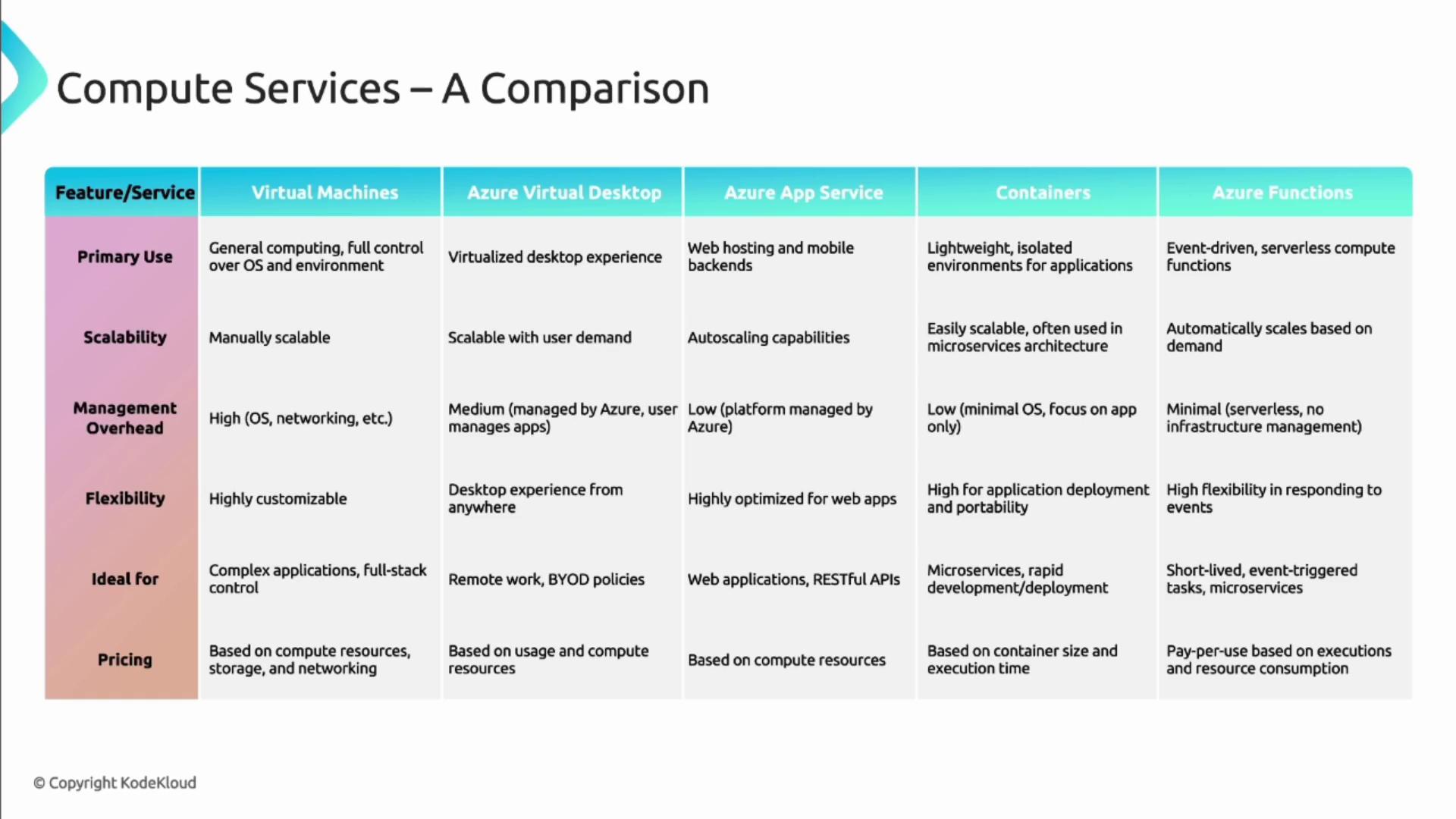AZ900: Microsoft Azure Fundamentals
Compute and Networking
Compare Compute Services
This article provides an in-depth comparison of various Azure compute services, helping you discern their distinct functionalities and determine which service best fits your workload requirements.
Primary Use
Virtual Machines (VMs):
VMs offer a traditional IaaS cloud computing approach, providing complete control over the operating system and environment. They are ideal for general computing tasks that demand extensive customizability.Azure Virtual Desktop (AVD):
AVD delivers a virtualized Windows desktop experience, enabling secure remote access from virtually any location. It is especially beneficial for organizations with remote workforces.Azure App Services:
Specifically optimized for hosting web applications and mobile backends, Azure App Services streamline the entire development to deployment workflow, making it the go-to option for RESTful APIs and dynamic web applications.Containers:
Containers provide lightweight, isolated environments that ensure consistency across diverse computing infrastructures. Their portability makes them perfect for microservices architectures and rapid deployment cycles.Azure Functions:
Azure Functions is designed for event-driven, single-purpose operations. This serverless compute option automatically scales and is optimal for executing short-lived tasks and integrating microservices.
Scalability
Virtual Machines:
Scaling VMs generally requires manual intervention, such as provisioning additional VMs or adjusting resource allocations. However, Virtual Machine Scale Sets are available for auto-scaling in response to varying demands.Azure Virtual Desktop:
Automatically scales based on the number of remote users, ensuring resources are dynamically allocated according to real-time user demand.Azure App Services:
Built with auto-scaling features, App Services adjust resource allocation automatically when encountering increased load.Containers:
Containers are inherently scalable, particularly when orchestrated with services like Azure Container Apps or Kubernetes Service, which efficiently manage scaling across microservices deployments.Azure Functions:
Functions automatically scale up or down based on the number of event triggers, eliminating the need for manual scaling configurations.
Management Overhead
Virtual Machines:
Being an IaaS offering, VMs entail high management overhead as you must maintain the operating system, network configurations, and other underlying details.Azure Virtual Desktop:
With Azure taking care of much of the infrastructure management, AVD has a moderate overhead, leaving you to focus primarily on application management.Azure App Services:
Enjoy a low management overhead since the platform is fully managed by Azure, removing the need for routine infrastructure maintenance.Containers:
Containers incur minimal management demands, as they focus solely on application deployment rather than handling the underlying OS.Azure Functions:
The serverless architecture abstracts the infrastructure layer, meaning Azure Functions require minimal management effort.
Flexibility
Virtual Machines:
VMs provide extensive customization capabilities with full administrative control, making them suitable for running any compatible software on a bespoke environment.Azure Virtual Desktop:
Offers a flexible desktop environment that users can access from any location, ensuring consistency in remote working conditions.Azure App Services:
Provides an optimized environment tailored for specific runtimes in web applications, though it offers less flexibility for installing arbitrary software.Containers:
Containers excel in flexibility, enabling rapid deployment and ensuring portability across varied computing platforms and environments.Azure Functions:
These functions offer substantial flexibility by efficiently handling various event triggers and seamlessly integrating with other Azure services.
Ideal Use Cases
Virtual Machines:
Best for enterprise-level applications requiring full-stack customization and complete control over the environment.Azure Virtual Desktop:
Perfect for organizations embracing remote work or BYOD policies, offering a consistent virtual desktop experience.Azure App Services:
Ideal for developers focused on deploying web applications, RESTful APIs, and mobile backends with speed and reliability.Containers:
Well-suited for microservice-based architectures and scenarios that demand fast development cycles and frequent deployments.Azure Functions:
Most effective for executing short-lived, event-triggered operations and lightweight microservices applications without server management.
Pricing Model
Virtual Machines:
Pricing is based on factors such as compute resources, storage, and networking.Azure Virtual Desktop:
Costs are determined by user demand and the compute resources allocated to support remote users.Azure App Services:
Pricing depends on the selected compute resources and the scale of the application.Containers:
Generally, pricing is calculated based on container size and the duration of execution.Azure Functions:
Operates on a pay-per-use model, where costs are incurred based on the number of executions and the corresponding resource consumption.

Additional Resources
For more detailed insights into Azure compute services and advanced topics, explore the AZ-305: Microsoft Azure Solutions Architect Expert exam resources and complete decision flowcharts on service selection.
This comprehensive comparison aims to simplify your decision-making process when choosing the right Azure compute service. Next, we will delve into networking to further enhance your cloud infrastructure strategy.
Watch Video
Watch video content